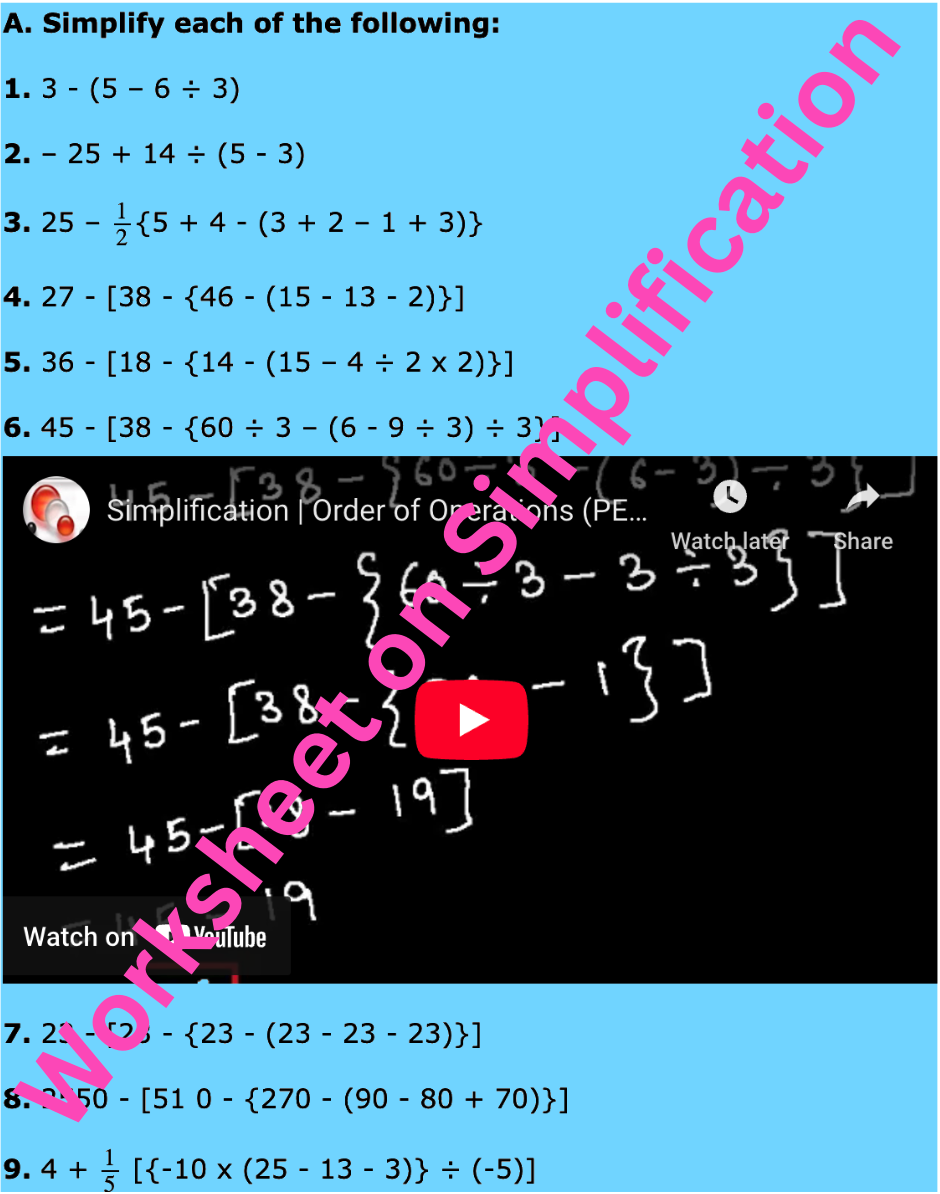Solution of an Equation
A solution of an equation is a value of the unknown variable that satisfy the equation.
A number, which when substituted for the variable in an equation makes its L.H.S equal to the R.H.S, is said to satisfy the equation and is called a solution of the equation.
Solving an Equation by Trial and Error Method:
Finding the solution of an equation is called solving the equation.
Trial and Error Method is used to solve an equation (linear equation).
Working Rules for this method are given below.
Working Rules for Solving an Equation by Trial and Error Method:
Step I: Take any equation.
Step II: Put several values of the variable and find the values of L.H.S and R.H.S. of the equations.
Step III: When for a particular value of the variable, L .H.S = R.H.S, then that value of the variable is solution of the equation.
Solved Example on Trial and Error Method:
1. Using trial and error method, find the solution of 5z = 10
Solution:
The given equation is 3z = 12
Since R. H.S. of the this equation is 12, therefore, we put several values of z to find L.H.S till for a particular value of z, it becomes equal to 12.
|
z |
L.H.S. |
R.H.S. | |
|
1 |
3 × 1 = 3 |
12 | |
|
2 |
3 × 2 = 2 |
12 | |
|
3 |
3 × 3 = 9 |
12 | |
|
4 |
3 × 4 = 12 |
12 |
Thus, z = 4 is the solution of the given equation.
Direct Way of Solving an Equation
(Solving an Equation by The Method of Transposition):
Trial and error method is not a direct and practical way for finding a solution. We shall now look for a direct way of solving an equation i.e., finding the solution of the equation.
Working Rules for Direct Way of Solving an Equation:
To Solve an Equation by the Method of Transposition
Step I: Add the same number or quantity to each side of the equation without upsetting the balance of the equation.
Step II: Subtract the same number or quantity from each side of the equation without upsetting the balance of the equation.
Step III: Transfer (or transpose) any number or quantity from one side of the equation to the other side by changing its sign i.e., + to -or - to +.
Step IV: Multiply or divide both sides of the equation by the same number or quantity without upsetting the balance of the equation.
Step V: Transfer (or transpose) the numerical coefficient of any quantity at L.H.S. to R.H.S. as its denominator whereas the denominator of the L.H.S. gets transposed to R.H.S. as its numerator.
Solved Example on Direct Method to Solving an Equation:
1. Solve x + 6 = 23
Solution:
Adding -6 (the additive inverse of +6) to both the sides, we get
x + 6 - 6 = 23 - 6
or, x = 17
or, x = 17 is the required solution.
2. If 9t = 63 then find the value of t.
Solution:
To find the value of t, eliminate its numerical coefficient of 9 by multiplying both the sides of the equation by 19
So, 9 × t × 19 = 63 × 19
or, t × 1 = 7 × 1
or, t = 7
Hence, t = 7 is the solution of the equation 9t = 63.
From Solution of an Equation to HOME PAGE
Didn't find what you were looking for? Or want to know more information about Math Only Math. Use this Google Search to find what you need.
Recent Articles
-
Counting Numbers from 1 to 50 | Match the Number | Missing Numbers
Apr 04, 25 03:46 PM
In counting numbers from 1 to 50, recognize the numbers, count and then join the numbers in the correct number order. Here we mainly need eye-hand coordination to draw the picture and maintain the num -
Counting Eleven to Twenty with Numbers and Words |Numbers from 11 - 20
Apr 04, 25 03:21 PM
Counting eleven to twenty with numbers and words are explained below. One ten and one more is eleven. Eleven comes after ten. One ten and two more is twelve. Twelve comes after eleven. -
5th Grade BODMAS Rule Worksheet | PEMDAS | Order of operations|Answers
Apr 03, 25 03:11 PM
In 5th Grade BODMAS Rule Worksheet you will get different types of problems on mathematical expressions involving different operations, mathematical expression with 'brackets' and 'of' and simplifying… -
Worksheet on Simplification | Simplify Expressions | BODMAS Questions
Apr 03, 25 02:58 PM
In worksheet on simplification, the questions are based in order to simplify expressions involving more than one bracket by using the steps of removal of brackets. This exercise sheet -
Divisible by 2 Video |Test of Divisibility by 2 Trick| Rules| Examples
Apr 03, 25 10:25 AM
A number is divisible by 2 if the digit at unit place is either 0 or multiple of 2. So a number is divisible by 2 if digit at its units place is 0, 2, 4, 6 or 8.





New! Comments
Have your say about what you just read! Leave me a comment in the box below. Ask a Question or Answer a Question.